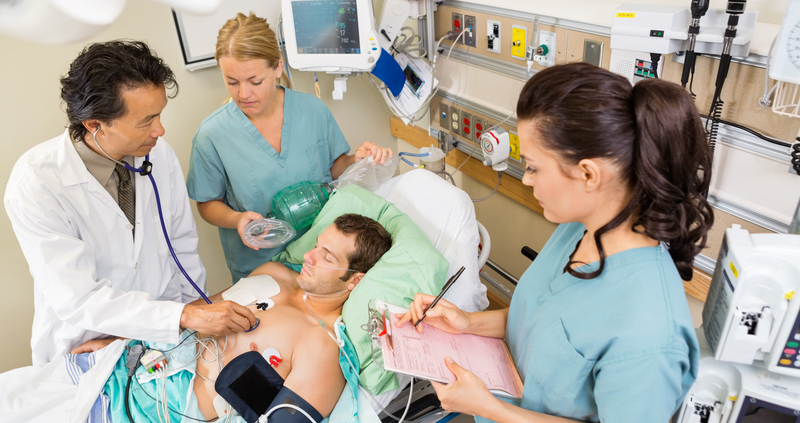How Does Infection Spread in a Hospital?
In this post we’ll discuss how infections spread in hospitals and explore some ways you can prevent and control infections in your hospital.
Ways Infections Spread in Hospitals
Most hospital-acquired infections (HAIs) spread in one of two ways:
- As a result of treatment.
- From person-to-person, or via another communicable disease vector (pathogens on a surface, or in the air, for example).
You can read our guide to the most common hospital-acquired infections.
How Infections Spread as a Result of Treatment
Some hospital-acquired infections can spread as a direct result of certain medical treatments.
Examples include:
- Surgical Site Infections (SSIs) – Invasive procedures involve making incisions in a patient’s skin. Though such procedures are performed in highly controlled sterile environments, it’s possible for incision wounds to get contaminated by microorganisms from the patient’s own body, or from outside sources.
- Clostridium difficile infections (CDIs) – diff bacteria can exist harmlessly in the bowel. But a course of antibiotics can sometimes cause a bacterial imbalance in the gut, triggering a CDI.
How Communicable Diseases Spread in Hospitals
A patient or a member of staff might bring an existing infection into a healthcare setting such as a hospital. Or a patient may develop an infection during their hospital stay while receiving treatment for an unrelated condition.
These are communicable diseases, and they can spread in a number of ways:
- From Person-to-Person – Coughs, sneezes, and even touches can spread viruses and bacteria from person to person. CDI, for example, is a common hospital-acquired infection because a major symptom is diarrhoea, which can act as a vector for the spread of bacteria. And of course, during the 2020 pandemic it became clear just how quickly Covid-19 can spread from person-to-person in a hospital.
- Indirect Contact – Viruses, bacteria, and other pathogens can survive for hours, or even days, on surfaces and inanimate objects. A patient may cough or sneeze into their hand. If they then use a doorhandle or a light switch, any staff member or patient who subsequently touches that item may pick up their germs. And if they then touch their mouth, nose, or eyes, they may introduce the germs into their bloodstream.
- Contamination – Finally, eating or drinking contaminated food or water can spread communicable diseases. E. coli, for example, is a common hospital-acquired infection, and it can be contracted from eating undercooked meat.
How To Prevent The Spread of Diseases in a Hospital
The National Institute for Health and Care Excellence (NICE) issued recommendations that could help prevent SSIs in hospitals. These include a series of steps for the preoperative phase (including showering and nasal decolonisation), recommendations for staff and patient theatre wear, and a series of checks to make both before and after the procedure. Read the full NICE guidelines for preventing SSIs here.
When it comes to controlling communicable diseases, hospitals must follow the standard infection control precautions (SICPs):
These include:
- Patient placement – Perform a comprehensive infection risk assessment for each patient, and isolate patients with a high risk of cross-infection.
- Hand hygiene – Follow a specific hand-washing technique to thoroughly clean your hands at key touchpoints – such as before and after interacting with a patient and their surroundings. Also advise patients to follow good hand hygiene guidelines and provide plenty of handwashing stations throughout your hospital.
- Personal protective equipment (PPE) – There should be clear procedures for what PPE to use and when. You should also have procedures for storing, applying, removing, and disposing of PPE.
- Cleaning – Commit to safe management of both care equipment and the care environment. Thorough cleaning should take place regularly and on an ongoing basis. You should also have specialist procedures for cleaning, disinfection, and sterilization in the event of outbreaks, and for high-risk equipment and environments.
Read our full guide to standard infection control precautions in hospitals and healthcare settings.
Control the Spread of Hospital-Acquired Infections
At Cairn Technology, we’ve been helping both NHS and private hospitals prevent and control infections for over 20 years.
We can help you with:
- Hospital-grade air purifiers that can trap and kill up to 99% of pathogens in a room.
- Fluid management products, including DryMax absorbent mats which can absorb and contain spillages during procedures, for faster and more effective cleaning.
- A selection of infection control products, including the Virusolve+ range of antimicrobial cleaners and disinfectants.
- Specialist services, including flexible bio-burden level testing in theatres, anaesthetic rooms, and prep rooms.
To discuss how we can help you prevent and control infection in your hospital, get in touch to talk to one of our friendly experts today.



